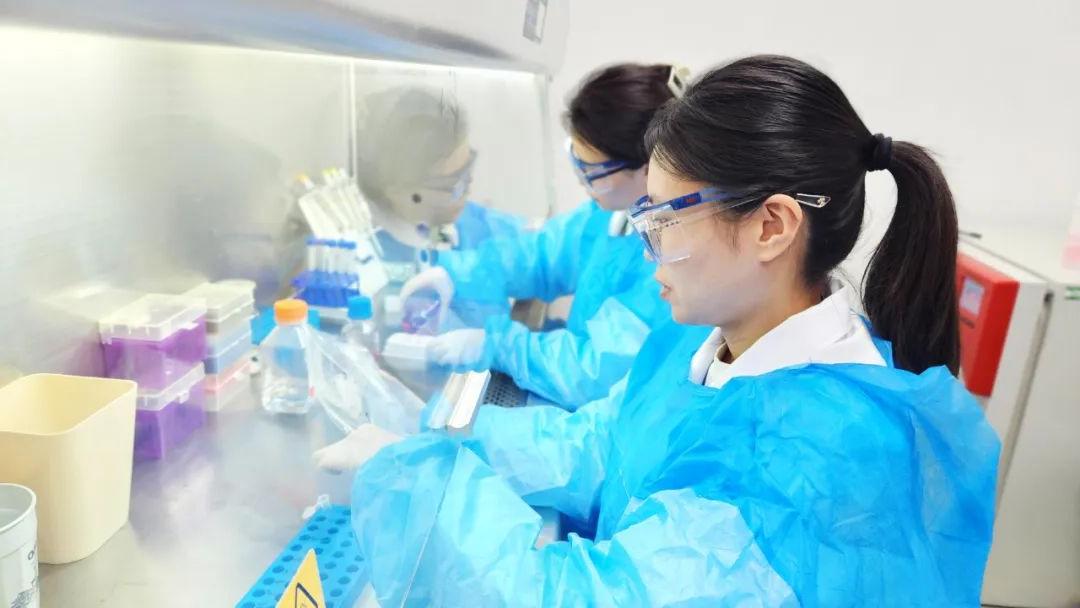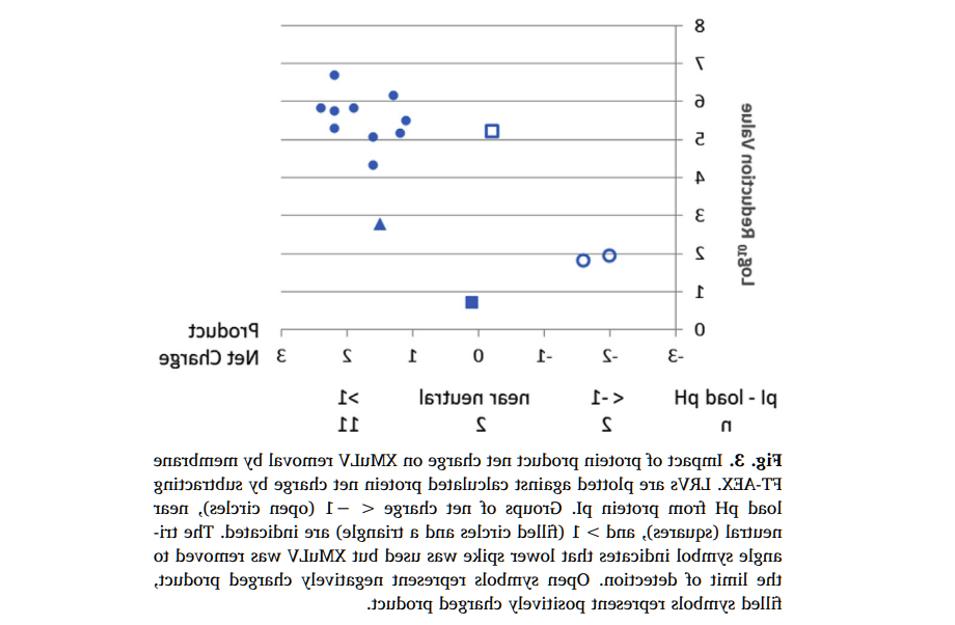
Virus removal by ion exchange chromatography can improve the safety of therapeutic protein products。The robustness of virus elimination depends on the electrostatic binding between the virus and the chromatographic media with opposite charges。然而,逆转录病毒异嗜性小鼠白血病病毒(XMuLV),即使在病毒和介质都带正电荷的情况下,其与介质之间的结合依然是稳健的。

该文献通过比较XMuLV和细小病毒的病毒-介质结合行为,来研究这种与正常预期相反的现象,这两类病毒在大小和结构上有很大差异,但是两者的等电点是相似的。When both viruses are negatively charged, the binding strength of XMuLV to the positively charged anion exchange medium is higher than that of parvovirus。When both viruses are positively charged, XMuLV binds tightly to the positively charged medium, but parvovirus is free。这些发现表明,XMuLV与填料的结合增强是通过局部电荷分布来实现的,细小病毒不具备这种特性,这种特性是设计层析工艺清除病毒稳健性能力的重要考量。


Therapeutic proteins are usually produced by anion flow (FT-AEX) chromatography and cation binding elution (BE-CEX) chromatography purification steps。These steps are mainly based on the strength of the different electrostatic interactions with the chromatographic medium to remove impurities and viruses from the product。理论上,病毒-介质的相互作用会受到病毒等电点(pI)、溶液pH、溶液离子强度(离子浓度)、病毒上可结合位点的数量以及竞争分子等因素影响。The studies reported so far have demonstrated some factors affecting the solution of virus clearance, but little is known about the effect of virus structure。

Regulatory authorities in the United States and Europe analyzed the virus removal studies submitted by the applicants and observed that the ion exchange chromatography step had significant virus removal potential。大量的数据证实,在通常情况下使用强阴离子交换或弱阴离子交换层析,可以获得稳健的逆转录病毒清除效果,尤其是在上样pH足够高的条件下。Consistent retrovirus-clearing effects have also been reported for BE-CEX。然而,目前还不清楚为什么小的、无包膜的细小病毒比大的、有包膜的逆转录病毒清除更不稳定且效果更差;为什么在pH 5的条件下,XMuLV和层析介质都带正电荷,XMuLV仍能与层析介质结合。Therefore, the comparison of virus-medium binding modes between coated XMuLV and uncoated parvovirus under the same conditions may provide new insights。
In this study, a large number of virus removal data of different virus models in FT-AEX and BE-CEX steps under the same conditions were analyzed head-to-head。通过这些数据从病毒结构特征以及多角度的影响,揭示了电荷相互作用的机制,包括检测在不同上样pH、电导以及使用更高等电点的模型病毒条件下病毒的清除效果。In addition to electrostatic interactions, this finding provides a qualitative explanation for the differences in virus-medium binding strength caused by the structural characteristics of the virus。



✔ 生产过程
本研究分析了60多个离子交换层析的病毒清除研究数据,以更好地了解驱动病毒清除的机制,并确定有利于稳健清除病毒的条件。In short, the cell culture liquid is collected by centrifugation or deep filtration for the first step of affinity capture chromatography。然后用低pH处理亲和产物来灭活包膜病毒。随后,采用经典的精纯纯化步骤进一步纯化蛋白,包括一步FT-AEX(精纯1)和一步BE-CEX(精纯2)。在某些情况下,FT-AEX作为精纯2步骤。最后进行病毒过滤、超滤置换及辅料添加制备原液。精纯1的产物中HCP残留是200 ng/mg,或者小于200 ppm,并且宿主细胞DNA低于检测限(<0.1 pg/mg)。Compared with pure 2, pure 1 sample liquid contains more impurities, and its HCP residue is more than ten times that of pure 2 sample liquid。
✔ 缩小模型
使用缩小模型模拟生产条件进行病毒清除研究。缩小模型的关键参数是层析介质类型(填料或者膜)、柱高、起始料液的成分、流速、溶液成分(包括pH和电导)、溶液体积、温度、载量和产物收集标准。In most cases, the effectiveness of the reduction model is demonstrated based on chromatographic characteristics, yield, and product quality。The results of analysis and testing show that the quality of the product is equivalent to that of mass production。检测方法包括:A280 nm法检测总蛋白、酶联免疫法检测HCP、PCR法检测宿主细胞DNA、体积排阻色谱检测纯度(用单体和聚体的百分比来表示)。The virus spiking assay and the identification assay used the same starting fluid, chromatographic column and operating parameters。三种阴离子填料和一种膜介质具有强阴离子交换剂的季胺基基团,一种阴离子填料具有强阴离子交换剂的聚乙烯亚氨基基团。阳离子填料具有强阳离子交换剂的硫丙基基团。
✔ 模型病毒和病毒测定
使用的六个模型病毒如表1所示,包括有包膜的异嗜性小鼠白血病病毒(XMuLV)、假狂犬病毒(PRV)和无包膜的病毒呼肠孤病毒3型(Reo3)、猿猴病毒40(SV40)、猪细小病毒(PPV)和小鼠细小病毒(MVM)。目前还没有文献报道PPV的pI。Two viruses, MVM and PPV, in ion-exchange chromatography experiments,没有表现出明显的差异,在遗传上密切相关,具有相似的二十面体衣壳组装和大小,49%的蛋白质具有同源性,即使表面电荷分布略有不同,相比于XMuLV,他们之间的总体差异很小。为了方便与XMuLV进行比较,本研究将MVM和PPV的实验结果作为细小病毒类别进行综合分析,并在图中用不同的符号进行说明。A high-purity viral suspension is used in the experiment, and the addition amount is usually 7-9 log10,添加比例≤1%。

Plaque testing or half of the cell culture infective dose (TCID50)测定病毒清除研究中样品的病毒滴度。In plaque testing, indicator cells are inoculated and cultured to a suitable density。对样品进行连续稀释、接种和孵育促使病毒复制。The plaque number was calculated after incubation, and then the virus titer (pfu/mL) was calculated based on the plaque number and the initial sample volume.。在TCID50For testing, the indicator cells were inoculated into 96-well plates and cultured to the appropriate density。对样品进行连续稀释、接种和孵育促使病毒复制。After incubation, the cytopathic effect was analyzed and the virus titer (TCID) was calculated by Spearman-Karber method50/mL)。所有实验均包括检测病毒的阴性和阳性对照实验。
此外,在病毒清除研究之前,对样品进行指示细胞的毒性测试和读数干扰测试,若发现样品浓度对实验结果有影响,则对样品进行适当的稀释来减小这些影响。在实验期间,将添加病毒后的上样样品保存在工艺温度下,作为病毒稳定性的对照,若其滴度低于上样样品,则用于计算log10降低值(LRV)。The virus distribution in flow, wash and high salt Strip samples was selectively detected to better study the virus clearance mechanism。
✔ 病毒清除实验
The virus removal assay determines the LRV by injecting the test virus into the raw feed solution, following a purification step, and comparing the amount of virus before and after each step。All experiments were repeated and analyzed using average LRV, including when the experiments were repeated with new and old fillers。新、旧填料的LRV差异都小于1.0 log10。只有在其他重复实验之间的差异超过1.0 log10情况下,采用较低的LRV。

✔ Effect of loading pH on virus removal by FT-AEX chromatography

In the FT AEX mode, a positively charged chromatographic medium captures negatively charged impurities and putative viruses while positively charged protein products flow through。For FT-AEX, strong anion exchange resins with quaternary amine groups or polyvinylimine groups were evaluated with a pH of 5.3~8.2范围内,电导率< 11 mS/cm。产品pI > 7,在该实验条件下蛋白带正电。
XMuLV在上样pH 6.3~8.2范围内,平均LRV为5.9 (n=24), of which 16 experimental groups achieved the detection limit of virus clearance, and only 1 group had LRV below 4 (Figure 1A, left).。In the same pH range, the effect of parvovirus clearance varied greatly, with an average LRV of 5.2(n=24),其中18个实验组病毒LRV > 4.0(图1A,中),另外6组细小病毒LRV < 4.0, all samples were from the purity 1 process step (Figure 1A, dashed box), indicating that impurities from earlier steps may have competitively bound to the virus。In addition, under the same conditions, parvovirus clearance was more affected by the conductivity of the solution, while XMuLV clearance was less affected by it (Figure 1C).。
当上样pH降低至5.3~6.1, either below or close to the virus pI (XMuLV pI=5).8,假设PPV pI接近6.2),XMuLV的平均LRV为6.3,PPV的平均LRV仅有1.7(图1A,右)。The case of monoclonal antibody with pI 7 was analyzed in depth, and the pH of the sample was changed from 5.3提高至6.4,PPV清除可以从LRV 1.9提高至LRV 5.9(图1D)。精纯2步骤的上样pH为5.3,初始料液的HCP < 5 ng/mg。精纯1步骤的上样pH为6.4,初始料液的HCP约为200 ng/mg。由于上样pH 6.The LRV was higher in 4 cases, suggesting that the competitive combination of HCP was not a key factor in this set of data。One possible explanation is that the net positive charge prevents parvovirus from binding to the AEX medium, while the net positive charge is not enough to prevent XMuLV from binding to the AEX medium。
✔ 膜层析FT-AEX清除病毒

当上样pH低于产品pI时,膜层析FT-AEX的季胺基基团清除病毒的趋势(图2)与层析柱FT-AEX相似(图1A)。上样pH在6.9和7.4以及5.0~6.3范围内,XMuLV清除都较为稳健(图2)。上样pH为6.9和7.4时,细小病毒的平均LRV是3.9(n=2)。上样pH在 5.0~6.In the range of 3, the pH of the samples was lower than or close to the virus pI, and the removal effect of parvovirus was poor。(图2,右,n=9,5 PPVS,4 MVMS)。
There are a number of potential reasons for the variation in LRV diversity, including competition from impurities or products and the purity and quality of the added viruses。然而,这组数据来自精纯2步骤,其初始料液具有低HCP和低于检测限的DNA,除了A组中的一个案例来自精纯1步骤(在图2中用菱形符号表示)具有高LRV。The product carries a positive charge, and membrane chromatography has the same effect on both viruses。These results and considerations together suggest that the charge state of the virus is the main driver of binding and that XMuLV binding may involve more complexity。
The LRV of the membrane chromatography FT-AEX (Figure 2) is slightly lower than that of the chromatographic column (Figure 1A)。However, LRV trends were similar across specific loading pH ranges: high LRV loading pH was near neutral, and low LRV loading pH was around 5.0~6.3范围内。In the absence of protein overload, a similar LRV trend was observed in the three viruses for membrane adsorption and chromatography column FT-AEX。Protein binding overload in membrane chromatography, especially in high impurity fluid, may lead to increased competition of parvovirus。In all cases, XMuLV binding was not significantly affected, except in this study where the sample pH was significantly higher than the product pI (see below).。
✔ Effect of product net charge on membrane chromatography FT-AEX clear XMuLV

In some cases, FT-AEX is used to purify negatively charged protein products, especially low pI proteins。膜层析FT-AEX的结果表明,带负电荷的蛋白产物不利于清除XMuLV(图3,左,开放圆圈),可能是由于产物和病毒竞争结合位点。这与蛋白产物带正电荷时,具有较高LRV(多数> 4.0)形成反差(图3,右)。
✔ BE-CEX
In the BE-CEX mode, positively charged impurities, hypothetical viruses, and protein products are bound to the chromatographic medium, while negatively charged impurities flow through。The product is then eluted at a suitable salt concentration, under which conditions the impurity and virus remain bound to the medium。本研究中上样pH多在4.5~7.0范围内,接近5.0, but in all cases the sample pH is lower than the protein pI, so the product carries a positive charge。
✔ 病毒类型对BE-CEX病毒清除的影响

BE-CEX的结果表明,XMuLV去除效果(n=24)是多变的,无细小病毒去除(n=7)效果(图4A)。7组案例中,其中3组XMuLV的LRV>4.0,剩余4组LRV<2.0.。在XMuLV稳健清除的案例中,病毒与填料紧密结合但未失活,其感染性可在高盐Stirp收集产物中恢复(图4B)。
✔ Influence of BE-CEX process conditions on XMuLV removal

The removal effect of XMuLV can be further grouped according to sample pH, elution pH, and salt concentration of elution buffer (Figure 5).。上样pH约为5时,洗脱前清洗或者不清洗,使用中等盐浓度进行洗脱,可有效地实现XMuLV的稳健清除(图5A, n = 16)。pH 5.Under 0 when elution with higher salt concentrations (n = 2), or at higher pH (5.9-8.5) During elution (n = 6), XMuLV and the product will co-eluate, and the virus removal effect will be significantly reduced (FIG. 5B).。XMuLV的清除依赖于洗脱pH和盐浓度,表明净电荷相互作用仍然是驱动病毒结合的关键动力,但这并不能解释细小病毒无法这样结合的原因。These results are consistent with previous BE-CEX virus removal results。
✔ Influence of virus isoelectric point on BE-CEX virus removal effect

如果静电相互作用是驱动病毒去除的关键因素,则可以预测在高洗脱pH条件下,BE-CEX能有效去除较高pI的病毒。PRV就是这样,它的pI是7.6。在pH 5.9-8.Under the elution condition of 5, the LRV of XMuLV, parvovirus, Reo 3 and SV40 were all less than 2.0,但PRV的LRV大于5.0(图6)。Infectivity testing showed that PRV was tightly bound to the filler and was not inactivated in the product environment (data not shown)。

When screening for optimal AEX parameters using a 96-well high-throughput approach, the binding of XMuLV to the AEX medium at pH5 was observed as opposed to what would normally be expected。本研究提供了全面的病毒清除数据,证实携带净正电的XMuLV确实可以与带正电的AEX介质高强度结合(图1和图2)。
Protein binding on charged surfaces was studied using a coarse-grained model to bind a single amino acid mutant。The results show that the local charge or microenvironmental region is more important for binding than the overall protein net charge。As recently observed using structural illumination microscopy and computed averages, proteins on the viral membrane are mobile and capable of forming functional clusters。这些观察结果共同支持以下假设:XMuLV表面带负电荷的、局部的、潜在的可移动的蛋白可能是XMuLV与阳性AEX介质结合的原因。细小病毒没有膜,因此不具有这种特性。
Glycosylated proteins on the surface of XMuLV may play a role, and deglycosylated XMuLV binding patterns can be detected in future studies。The variable shape, large size, and local charge distribution of XMuLV's lipid membranes may contribute to increased binding strength over long distances。相反,细小病毒体积较小、形状固定、没有脂质膜、没有糖基化蛋白,表明在电荷相互作用的背景下,细小病毒表现得与传统蛋白更为相似(图7)。

基于本研究的综合分析,在相同的FT-AEX条件下,相对于XMuLV,细小病毒展现出与层析介质更弱的结合能力。pI略高的细小病毒可能也有利于弱结合。For example, BE-CEX chromatography carries less positive XMuLV (pI~5) when loading pH5.8) It can still have a high bonding strength with CEX media, eluate in a high salt state, and separate from the product (Figure 4B)。Under the same conditions, parvoviruses carry more positive charges (pI~6.2) Still can not effectively bind, because it is recovered in the flow part and eluent part (data not shown)。These observations suggest that the weak binding strength of parvovirus is related to structure, not to net charge。
在Protein A层析研究中,发现XMuLV与单抗体共结合和共洗脱,LRV一般在1~4 logs之间。In contrast, FT-AEX enables robust scavenging of XMuLV with LRV above 4 logs。This indicates that co-binding and co-elution of the virus with the product will result in lower virus clearance effect。
表2总结了在本研究中稳健清除病毒的情况。Compared with parvovirus, XMuLV showed stronger binding ability to the chromatographic medium, which was more conducive to the robust elimination of the virus。The larger shape and local structure of XMuLV can increase the diversity of interactions, similar to the affinity concept of antigen-antibody interactions。由于病毒-介质结合发生十分迅速,在结合能力限度内,相对于病毒结构和电荷状态,流速/保留时间和柱高等工艺参数对病毒清除的影响非常小。Thus, the prediction of virus-clearance robustness by ion-exchange chromatography can be simplified。

XMuLV与填料结合强度很大,这也是因为,与细小病毒相比,XMuLV的清除几乎不受层析过程中杂质竞争的影响(比如,精纯1步骤的起始料液中存在酸性HCP)(图1A)。只有当病毒和产物具有相同的电荷状态时,XMuLV清除才会受到影响(图3),这种情况下,产物的数量可能超过杂质数量的几个数量级。Therefore, our data further support FT-AEX in sample pH7.0-8.5,电导率< 14 mS/cm时,平均LRV> 5.0。These conditions also apply to membrane-based FT-AEX chromatography (Figure 2).。XMuLV在相同条件下,如果料液中存在少量竞争杂质,细小病毒也可以实现平均LRV> 5.0(图1A,中)。
在相同的条件下,BE-CEX可以实现稳健的XMuLV清除效果,平均LRV> 4.0(图5)。In addition, the results show that BE-CEX can complement FT-AEX to clear the virus。For example, a parvovirus with a pI of 8 cannot BE cleared when the sample pH is close to 7, but may be cleared by BE-CEX (Figure 6).。

The removal of virus by ion-exchange chromatography depends on the electrostatic interaction, but the virus structure and size will affect the interaction strength and the robustness of the process。本研究证明FT-AEX、BE-CEX的单步层析或者两步联用,在特定的上样pH和电导率条件下,多种病毒可以被稳健地清除。
Through this study, it is possible to identify and avoid the specific conditions in which the virus clearance ability is reduced, so as to adopt the sample pH of 7 in practice.0~8.In the range of 5, the method of electrical conductivity less than 14 mS/cm for product virus safety risk assessment, rather than the traditional experimental assessment。This also saves resources for implementing integrated strategies to minimize the overall risk of viral contamination。




